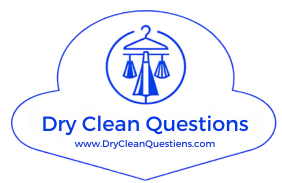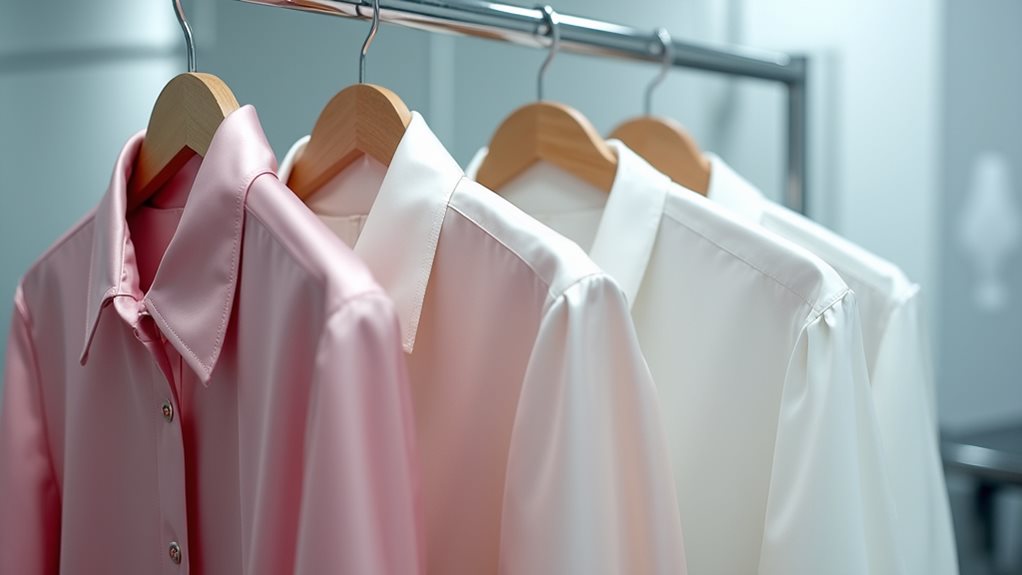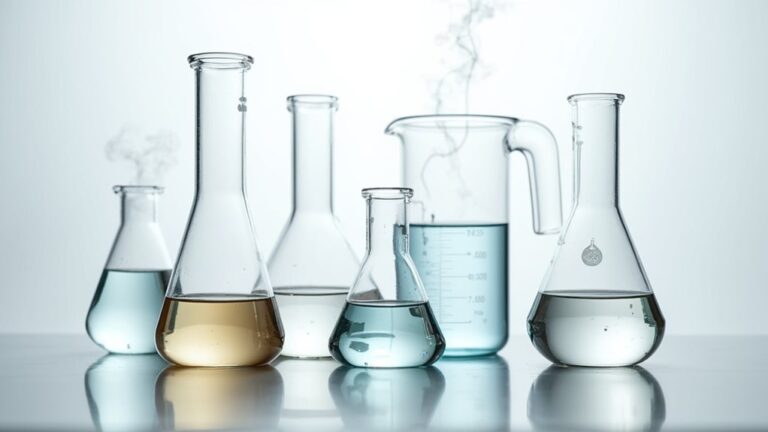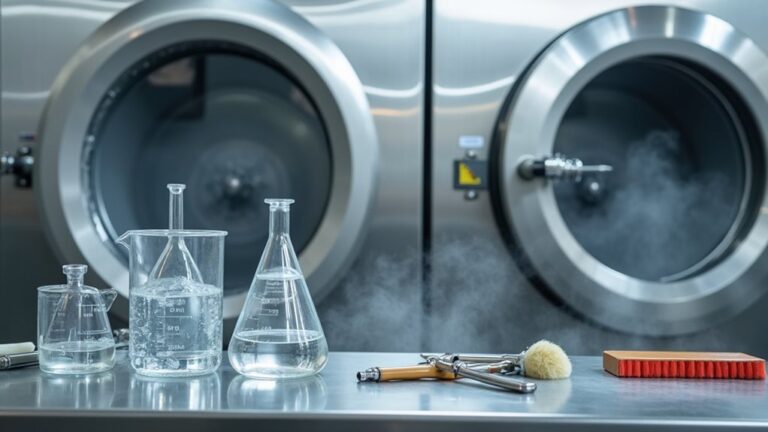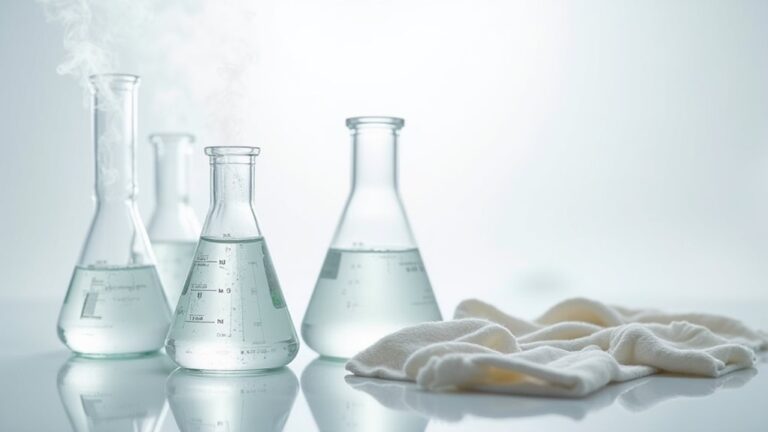When you drop off your clothes at the dry cleaner, they’re tagged, sorted, and inspected for stains before receiving targeted pre-treatment with specialized solutions. Your garments then get cleaned in machines using chemical solvents like perchloroethylene instead of water, protecting delicate fabrics from shrinking or damage. After thorough quality control checks and any necessary spot treatments, skilled technicians professionally press and finish your items using steam and heat. The entire process transforms your wrinkled, stained pieces into pristine garments while the behind-the-scenes details reveal fascinating environmental considerations you’d never expect.
The Initial Tagging and Sorting Process
When you drop off your favorite blazer or that delicate silk blouse at the dry cleaner, the first thing that happens behind the counter might surprise you – it’s not immediately whisked away to some magical cleaning chamber, but rather begins a methodical process that starts with what I like to call the “detective work” phase.
Behind every pristine garment lies meticulous detective work that transforms your cherished clothing into professionally cleaned perfection.
Each of your garments receives a unique identification tag, much like a hospital bracelet, guaranteeing nothing gets lost in the shuffle.
Then comes the sorting magic, where skilled technicians group items by fabric type, examining cleaning requirements while conducting thorough inspection for pre-existing damage and stubborn stains.
During this inspection phase, technicians also apply specialized pre-treatment solutions to tackle any visible stains before the actual cleaning process begins.
This careful attention to detail drives both efficiency and customer satisfaction.
Garment Inspection and Stain Pre-Treatment
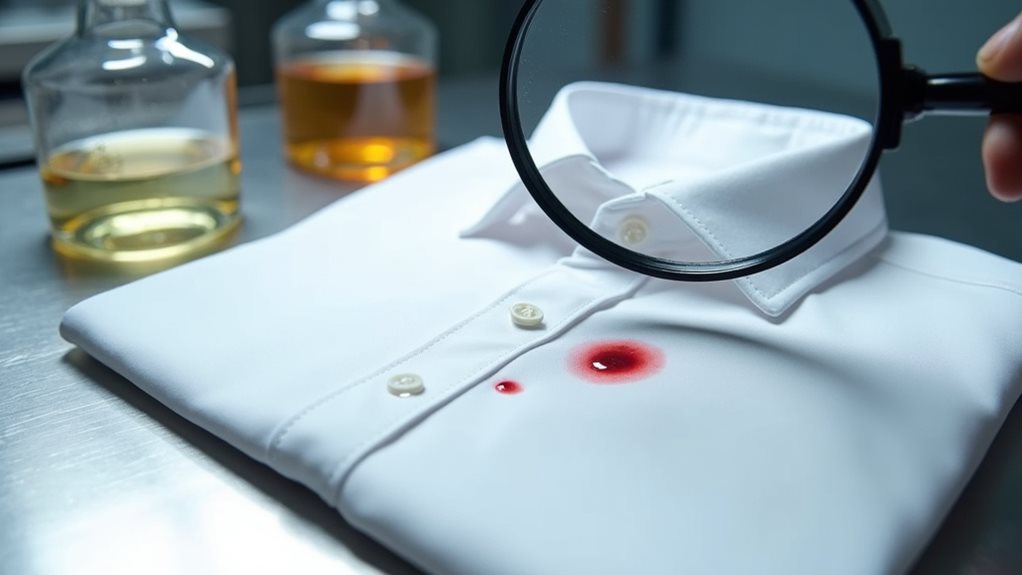
After your garments receive their tracking tags, they’re carefully examined by experienced technicians who assess each piece’s condition, checking for existing damage, wear patterns, and any forgotten treasures you might’ve left in pockets 😊.
This inspection process resembles a detective’s methodical approach, as professionals identify every stain’s unique characteristics—whether it’s that stubborn wine spill from last week’s dinner party or mysterious grease marks that somehow appeared on your favorite blazer.
You’ll appreciate knowing that each stain gets categorized by type and composition, allowing the team to select precisely the right pre-treatment formula that’ll give your clothes the best chance of emerging spotless and pristine.
During this crucial phase, technicians pay special attention to delicate fabrics like silk and wool that require gentle handling to prevent damage during the cleaning process.
Garment Condition Assessment
The moment your favorite blazer or delicate silk blouse arrives at the dry cleaner, it undergoes what I like to call the “detective phase” – a thorough inspection that’s honestly more meticulous than how I examine my own clothes before tossing them in my hamper 😅.
During this essential garment inspection, professionals scrutinize every inch for damage, stains, and forgotten treasures lurking in pockets, because nothing ruins a cleaning process quite like a melted candy bar.
They’ll assess your fabric type and construction to determine the perfect cleaning method, since silk requires completely different treatment than wool.
Each stain gets pre-treated with specialized solutions, while embellishments receive special attention to preserve both integrity and appearance throughout the entire process.
This careful preparation ensures that chemical solvents like perchloroethylene or eco-friendly alternatives can effectively dissolve oils and dirt without causing damage to delicate fabrics.
Stain Identification Process
Every single stain tells a story, and honestly, I’ve become something of a forensic investigator when it comes to deciphering the tales my clothes whisper about my weekend adventures 🕵️♀️.
During garment inspection, your dry cleaner carefully examines each piece, identifying different stain types that require specific approaches for effective removal.
The stain identification process determines which specialized chemicals will work best on your fabric types, because oil-based stains need completely different pre-treatment than protein-based ones.
This targeted stain removal step happens before the actual dry cleaning process begins, and it’s absolutely vital for tackling stubborn stains.
Professional cleaners also evaluate whether previous cleaning attempts have made the stain worse, as this can significantly impact the stain removal strategy and overall success rate.
Here’s what makes this identification so important:
- Different stains demand different solutions – coffee versus wine requires completely separate approaches
- Proper identification prevents permanent damage – wrong chemicals can set stains forever
- Expert assessment maximizes your cleaning outcome – professionals spot things you’d miss
Machine Cleaning With Chemical Solvents
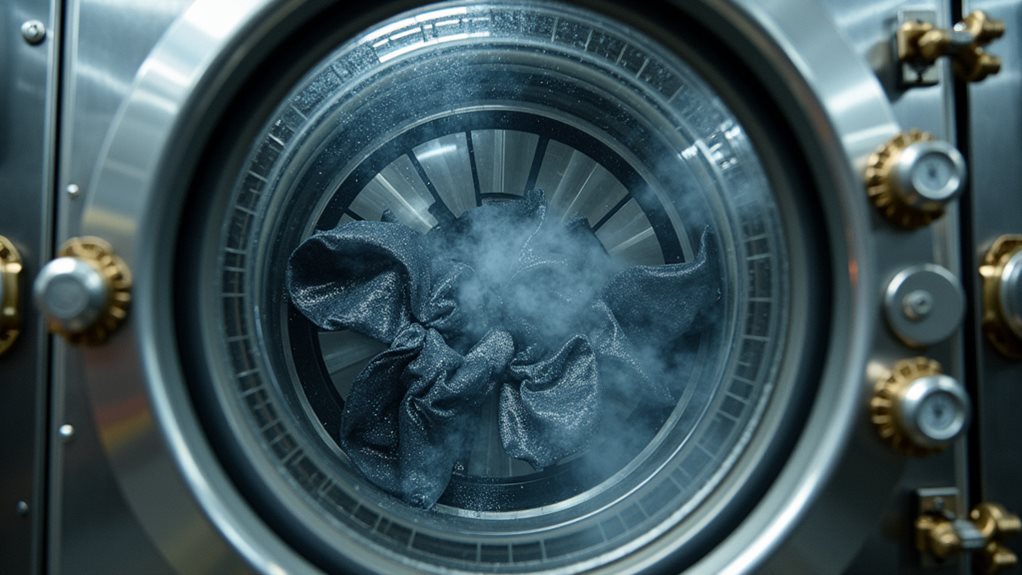
Once your beloved garments disappear behind the counter at your local dry cleaner, they commence a fascinating expedition through specialized machines that work like molecular magicians, using chemical solvents instead of water to lift away stubborn stains and everyday grime.
Your clothes enter a dry cleaning machine where perchloroethylene, the superhero of chemical solvents, gently bathes them at cool temperatures around 30°C, protecting delicate fabrics from heat damage.
The cleaning process involves careful agitation that improves stain removal without compromising texture, and here’s the cool part—solvent recovery systems capture 99.99% of the chemicals for reuse, dramatically reducing environmental impact.
After thorough inspection guarantees every spot’s vanished, your garments emerge refreshed and ready.
This solvent-based process is particularly essential for delicate materials like wool and silk that would suffer damage from traditional water-based washing methods.
Post-Cleaning Quality Control and Spot Removal

Once your clothes emerge from their chemical bath, they’re not quite ready for your closet yet, and honestly, I learned this the hard way when I picked up a “clean” blazer that still had a mysterious coffee stain glaring at me like an accusation.
The dry cleaner’s team now becomes part detective, part magician as they conduct a thorough final inspection, hunting down any stubborn stains that somehow survived the initial cleaning process, because let’s face it, some spots are more determined than others.
This post-cleaning quality control phase involves targeted spot treatment using specialized techniques, rigorous quality assurance checks that would make a perfectionist weep with joy, and a final pressing that transforms your wrinkled garments back into their crisp, professional glory. ✨
During this stage, any remaining chemical solvent is carefully removed through controlled heat and air circulation to ensure your garments are completely safe to wear.
Final Garment Inspection
After your garment emerges from the dry cleaning machine, it’s not quite ready to head back to your closet just yet—this is where the real detective work begins.
During final inspection, experienced technicians examine every inch of your garment with the intensity of a forensic investigator, checking whether those stubborn stains have truly surrendered to the cleaning process.
This quality control phase catches what automated machines might miss:
- Persistent stains that need additional spot removal attention
- Damages or loose threads requiring immediate repair
- Overall condition ascertaining your garment meets pristine standards
Once everything passes inspection, your cleaned garment gets pressed to eliminate wrinkles, then carefully packaged in protective plastic—because nobody wants their freshly cleaned clothes arriving wrinkled! 😊
This thorough inspection process is particularly crucial for delicate materials like silk, wool, and leather, which require specialized care to prevent damage during the cleaning process.
Persistent Stain Treatment
When that eagle-eyed technician spots a stubborn stain that somehow survived the dry cleaning process, your garment isn’t destined for the “good enough” pile—instead, it heads to what I like to think of as the stain removal emergency room.
Here, trained professionals deploy advanced stain removal equipment and targeted chemical treatments, because persistent stains demand respect, not surrender.
These spot removal techniques aren’t one-size-fits-all solutions; they’re carefully chosen based on the stain’s personality and your fabric’s temperament.
Quality control means your garment undergoes a second inspection after treatment, and honestly, some stubborn stains require multiple treatments to achieve ideal results—think of it as stain therapy sessions! 😊
Success rates for stain removal depend heavily on factors like stain age, fabric type, and whether the garment has been previously heat-treated.
Quality Assurance Standards
While your freshly cleaned garment might look spotless hanging there in the cleaning chamber, the real magic happens during the meticulous quality verification phase, where experienced technicians become fashion detectives armed with bright lights and magnifying glasses.
This quality control inspection guarantees you’re getting exactly what you paid for, because honestly, there’s nothing worse than discovering residual stains after picking up your “clean” clothes.
Here’s what makes this garment inspection so thorough:
- Targeted spot removal techniques using specialized pre-treatment solutions for stubborn marks
- Double-checking after the drying process to catch any missed imperfections
- Detailed records of stain removal treatments for consistent, personalized service
These quality verification standards transform good cleaning results into exceptional ones, maintaining service consistency that keeps you coming back.
This rigorous inspection process is particularly crucial for delicate fabrics like silk and wool, which require expert handling to preserve their integrity and appearance throughout the cleaning process.
Professional Pressing and Finishing Techniques
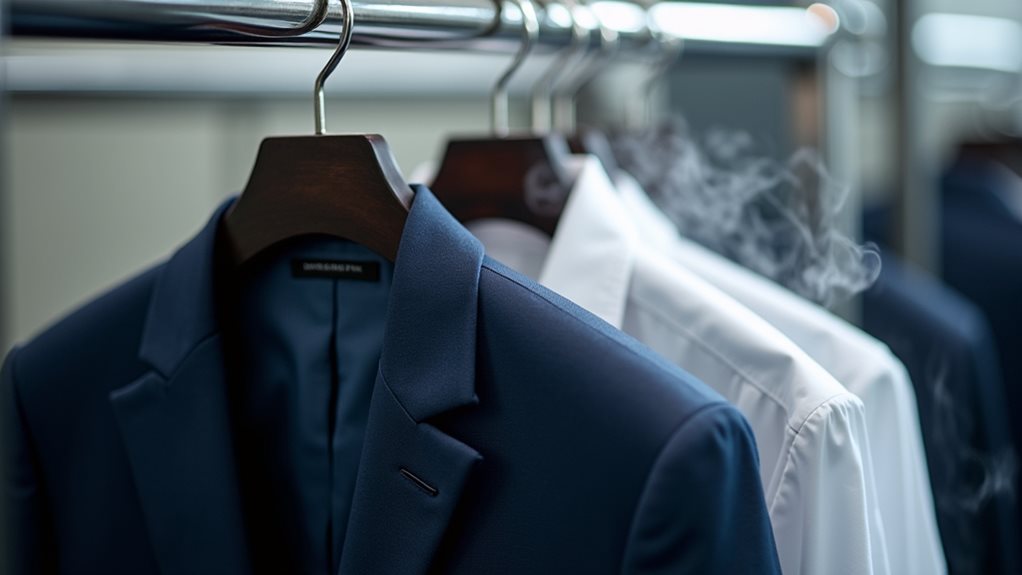
The magic really happens once your freshly cleaned garments enter the finishing stage, where skilled technicians transform wrinkled fabrics into crisp, professionally presented pieces that look better than when you first bought them.
Professional pressing combines steam and heat through specialized pressing machines that apply precise temperature and pressure, protecting delicate fabrics like your favorite silk blouse or wool blazer from damage.
These finishing techniques involve steamers, irons, and vacuum tables that create polished results without distorting fabric integrity.
Beyond pressing, technicians perform minor repairs—sewing loose buttons, fixing hems, spot-cleaning stubborn stains—enhancing overall quality and garment presentation.
This meticulous attention to detail drives customer satisfaction, proving that proper finishing separates mediocre dry cleaners from exceptional ones.
For professionals who regularly wear formal wear and business attire, this level of expert finishing becomes essential for maintaining the polished appearance their careers demand.
Environmental Impact and Sustainable Alternatives
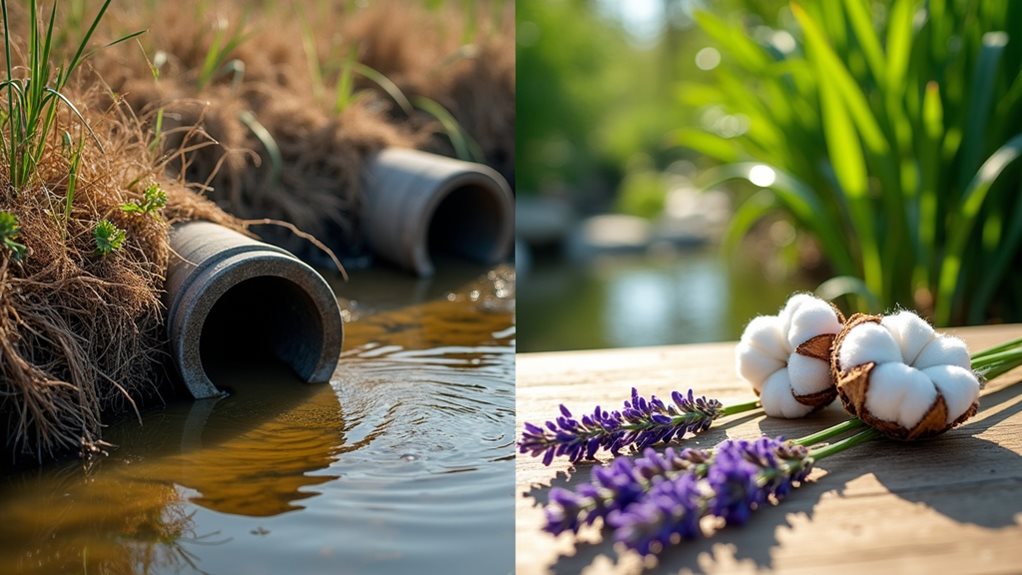
Although your favorite blazer emerges from dry cleaning looking pristine, there’s an environmental story unfolding behind those spotless results that might surprise you.
The dry cleaning industry has traditionally relied on perchloroethylene, a chemical that poses serious health risks and environmental concerns, which explains why you might notice that distinctive smell when you pick up your clothes.
Here’s what’s changing to protect both you and our planet:
- Liquid carbon dioxide cleaning uses pressurized CO2 instead of toxic chemicals
- Wet cleaning with biodegradable detergents offers gentler, water-based solutions
- Solvent recycling and energy-efficient machines help facilities recover 99.99% of chemicals
These sustainable alternatives prove that environmentally friendly solvents can deliver the same quality results you expect, just without the guilt.
